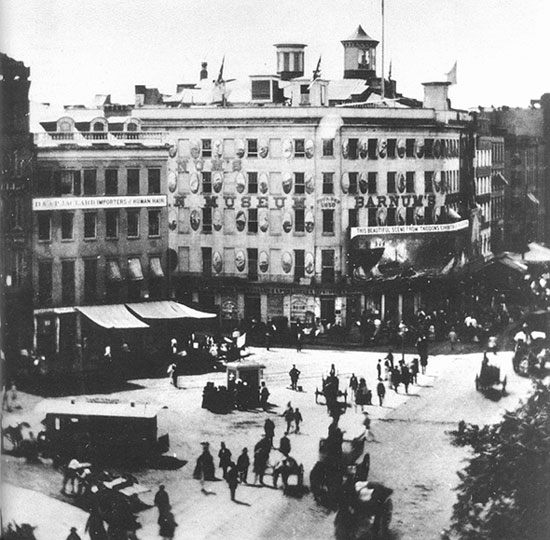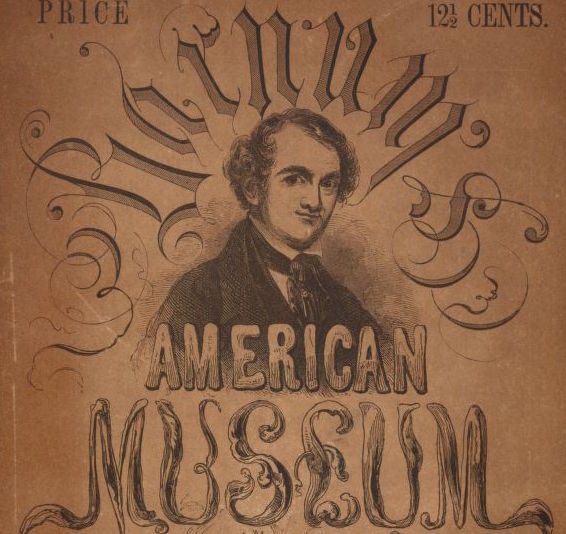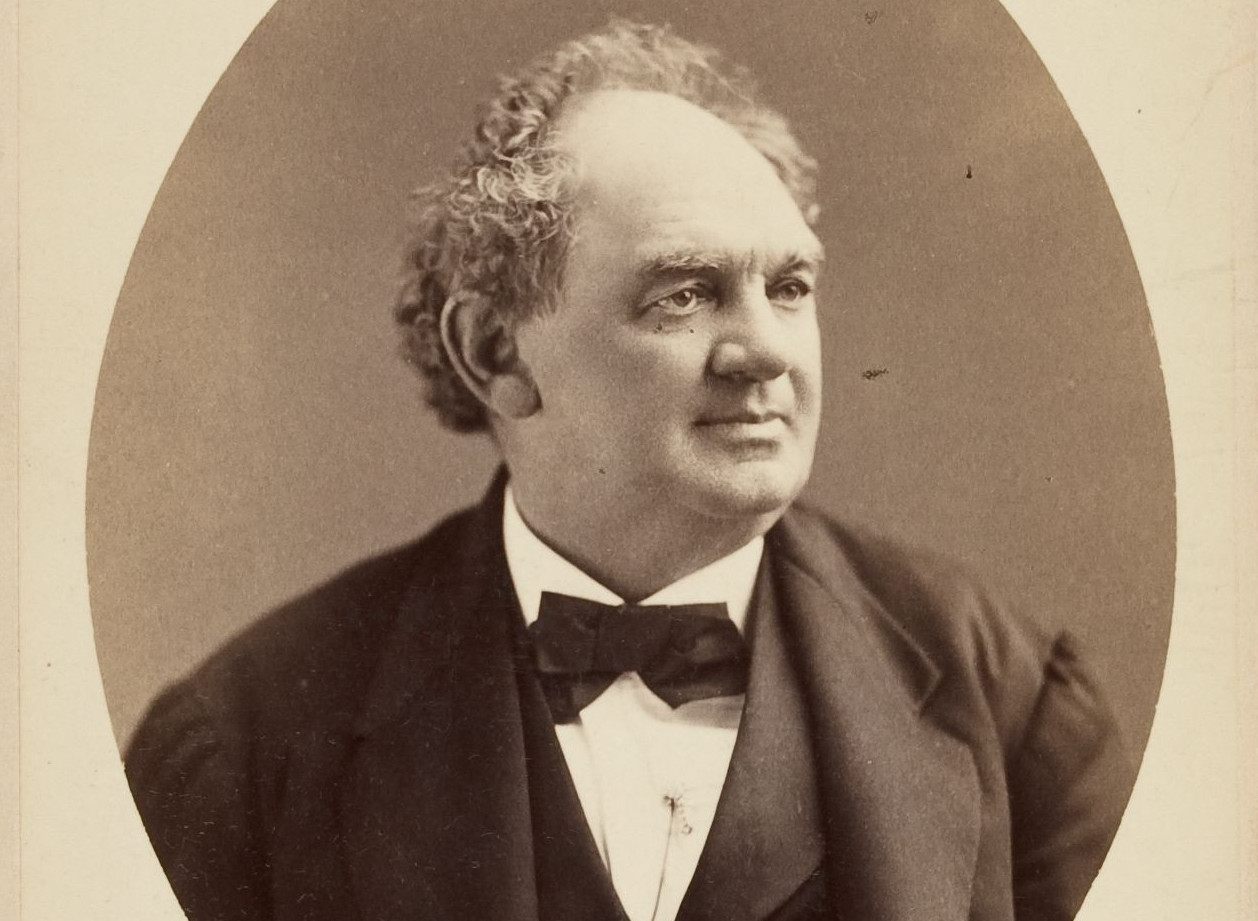The Cursed History of P.T. Barnum’s Museums
The greatest showman on Earth had a less-than-great run of disasters.

Barnum’s museums have a way of getting destroyed. (Photo: CircaSassy/Public Domain)
Step right up and see the Barnum Museum in exotic Bridgeport, Connecticut! It’s the final thrilling chapter in a story full of fiery disaster, and the whole thing is 100 percent true!
Long before P.T. Barnum became the famed 19th-century three-ring huckster most remember him as today, the man was a visionary museum proprietor. But whenever he dared to follow his dreams and establish his own museum, nature and fate seemed to conspire to destroy it. And this didn’t just happen once. It happened three times.
A business-minded entrepreneur from a young age, Barnum’s first foray into entertainment was with Barnum’s Grand Scientific and Musical Theater in 1840, a traveling show that earned him the capital to purchase and open his first museum, Barnum’s American Museum on Broadway in Manhattan.
The space, in a five-story, corner building was formerly known as Scudder’s American Museum. Barnum renamed it and began turning it into an attraction more reflective of the showman’s tastes. “Barnum’s mission statement was ‘instructive entertainment,’” says Kathleen Maher, Executive Director of the Barnum Museum. “Going all the way back to the 1840s, it was always his goal to go back to go back to [that mission].”
Barnum’s American Museum opened in 1842, and was an instant smash success. Inspired by Barnum’s love of both spectacle and knowledge, the American Museum became a wild mish-mash of exhibits that included live animals, an elegant lecture hall that hosted grand theater and luminaries, and the country’s first aquarium, which held a white whale in water pumped in from the East River. There were even human attractions such as famed conjoined twins Chang and Eng, a bearded lady, and “General Tom Thumb,” a dwarf who became one of Barnum’s lifelong friends.

Barnum’s first museum before it was destroyed. (Photo: Wikipedia/Public Domain)
While many of the attractions and practices at Barnum’s American Museum may seem cruel or inappropriate by today’s standards, the sheer wealth of fascinating exhibits turned the museum into a world-famous destination.
But the good times couldn’t last. In 1865 the first disaster to befall a Barnum museum came in the form of a fire that raged through the place, destroying the entire endeavor. It was a massive conflagration that reduced the building to rubble and spread to the entire block. All of the employees were able to evacuate, and no human lives were lost in the blaze, but many of the animals in the building were not so lucky. Some of them tried to escape by jumping out the windows, but they were shot by police officers. Others, such as the creatures in the aquariums, simply burnt up.
At the time, the New York Times blamed the fire on a “defective furnace,” but it may have been intentional sabotage. Barnum, who at the time of the first fire was serving on the Connecticut legislature, was a proud supporter of abolition, and it may have been these politics that caused the demise of his first museum. “Right after the Civil War, the American Museum was burnt down, and it was alleged to have been burned down by Southern sympathizers,” says Maher.

Barnum could never turn down the opportunity to put his face on something. (Photo: Library of Congress/10034181/Public Domain)
But Barnum’s dream could not be stopped, and he quickly opened a new museum just up the street from the smoking husk of his previous site. Not wanting to leave his employees in the lurch, Barnum had his second museum up and running within a year or so of losing the first one. Always enamored with the latest technology, Barnum used boilers, which were a novel new invention at the time, to heat this new location. Unfortunately these proved to be a bit too untested. “Boilers were new at that time,” says Maher. “A boiler explosion burnt down the second museum in 1868.”
Barnum just couldn’t win. He decided to get out of the museum business.
Choosing to focus on straight performance entertainment attractions, Barnum briefly operated a location on 14th Street in Manhattan (which also burned due to a boiler malfunction), and established what would become Madison Square Garden by turning one a former rail depot into a performance venue, before finally starting his circus. By this time, Barnum was in his 60s.
After Barnum got his fortunes back in line, and was spending his energies on the Greatest Show On Earth, he returned to his original love: instructive entertainment. Barnum decided to create a museum in Bridgeport, Connecticut, the chosen city that he had spent much of his time living in and improving throughout his life. Through his professional life, Barnum lived in Bridgeport, commuting to his museums in New York. The great showman spent a great deal of time improving the city, bringing in industry, and even serving as mayor for a time. His final act of philanthropy towards the city he loved was to establish the third Barnum Museum.

The current Barnum Museum (Photo: Garcicar/CC BY-SA 3.0)
While Barnum commissioned the domed building that houses the museum, he didn’t live to see its completion. Barnum passed away in 1891, aged 80. But not even death could stop the museum, as he had willed funds and a continuing endowment to keep it going. It was finally completed in 1893, and the stone, steel, and terra cotta building (Barnum wanted to avoid more fires) was opened as The Barnum Institute of Science and History.
Originally the building housed a group of scientific and historic societies, but in 1936, it became the Barnum Museum. The exhibits displayed artifacts including some of Barnum’s original writings, exotic curiosities from his collection, miniature Tom thumb carriages, and more. The building was renovated multiple times throughout the 20th century, and it seemed as though Barnum had finally created a museum that wasn’t susceptible to disasters.
Not so. In June, 2010, the Barnum Museum was ground zero for an anomalous EF-1 tornado that severely damaged the sturdy building. With the historic building damaged to the point of possible instability, the entire 20,000 item collection had to be loaded out and stored or sent to preservationists and conservation labs. Remarkably, only one item was irrevocably damaged. “[It was] an 1872 Barnum autobiography,” says Maher. “It was soaked beyond repair. It was just destroyed. Everything else that was really very wet was salvageable.”

P.T. Barnum, showman, philanthropist, disaster magnet. (Photo: Harvard College/Public Domain)
Today, after years of safety tests and inspections, Barnum’s miraculously sturdy steel and stone building has been deemed stable enough to once again house his museum, and the collection is slowly being returned, as renovations continue. Much like Barnum himself, the Barnum Museum is taking its catastrophic misfortune and using it as an opportunity to start fresh.
“The calamity has given us an opportunity to re-envision ourselves.” says Maher. “For the last five years we’ve been in disaster recovery operations with the historic building.” Now that they can get the museum back up and running, staff are devoting themselves to bringing Barnum’s vision back to life, working with a company that specializes in educational attractions to bring Barnum’s spirit to the museum, using the latest technologies and features. At least until the next disaster.
“People have thought it was a curse,” says Maher. “[But] there’s a good energy here. If there’s a curse, maybe it’s a good curse. Maybe it was time that Barnum looked down and said, ‘You’re not getting this done. Lemme send you a little help to get the museum up into the 21st century.’ And it happened to come as a tornado.”
Go behind the scenes at the Barnum Museum with us during Obscura Day, a worldwide day of exploration on April 16.
Update (3/30): This story initially stated that Thomas Edison spoke at Barnum’s first museum. He spoke at the current museum. It also stated that the Greatest Show on Earth got Barnum’s fortunes back in line. Barnum was actually in good financial shape by the time in question.




































Follow us on Twitter to get the latest on the world's hidden wonders.
Like us on Facebook to get the latest on the world's hidden wonders.
Follow us on Twitter Like us on Facebook